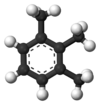1,2,3-Trimethylbenzene
|
|
|||
| Names | |||
|---|---|---|---|
|
IUPAC name
1,2,3-Trimethylbenzene
|
|||
| Other names
Hemellitol; Hemimellitol, Hemimelithol; Hemimellitine; Hemimellitene
|
|||
| Identifiers | |||
|
3D model (JSmol)
|
|||
| ChEBI | |||
| ChemSpider | |||
| ECHA InfoCard | 100.007.633 | ||
|
PubChem CID
|
|||
| RTECS number | DC3300000 | ||
|
|||
|
|||
| Properties | |||
| C9H12 | |||
| Molar mass | 120.20 g·mol−1 | ||
| Appearance | Colorless liquid | ||
| Density | 0.89 g/mL | ||
| Melting point | −25 °C (−13 °F; 248 K) | ||
| Boiling point | 176 °C (349 °F; 449 K) | ||
| 0.006% (20°C) | |||
| Vapor pressure | 1 mmHg (16.7°C) | ||
| Hazards | |||
| Main hazards | Flammable | ||
| R-phrases (outdated) | R10 R37 | ||
| S-phrases (outdated) | S16 | ||
| Flash point | 51 °F (11 °C) | ||
| 470 °F (243 °C) | |||
| Explosive limits | 0.8%-6.6% | ||
| US health exposure limits (NIOSH): | |||
|
PEL (Permissible)
|
none | ||
|
REL (Recommended)
|
TWA 25 ppm (125 mg/m3) | ||
|
IDLH (Immediate danger)
|
N.D. | ||
|
Except where otherwise noted, data are given for materials in their standard state (at 25 °C [77 °F], 100 kPa).
|
|||
|
|
|||
| Infobox references | |||
1,2,3-Trimethylbenzene is an organic compound with the chemical formula C6H3(CH3)3. Classified as an aromatic hydrocarbon, it is a flammable colorless liquid. It is nearly insoluble in water but soluble in organic solvents. It occurs naturally in coal tar and petroleum. It is one of the three isomers of trimethylbenzene. It is used in jet fuel, mixed with other hydrocarbons, to prevent the formation of solid particles which might damage the engine.
Industrially, it is isolated from the C9aromatic hydrocarbon fraction during petroleum distillation. It is also generated by methylation of toluene and xylenes.
...
Wikipedia


